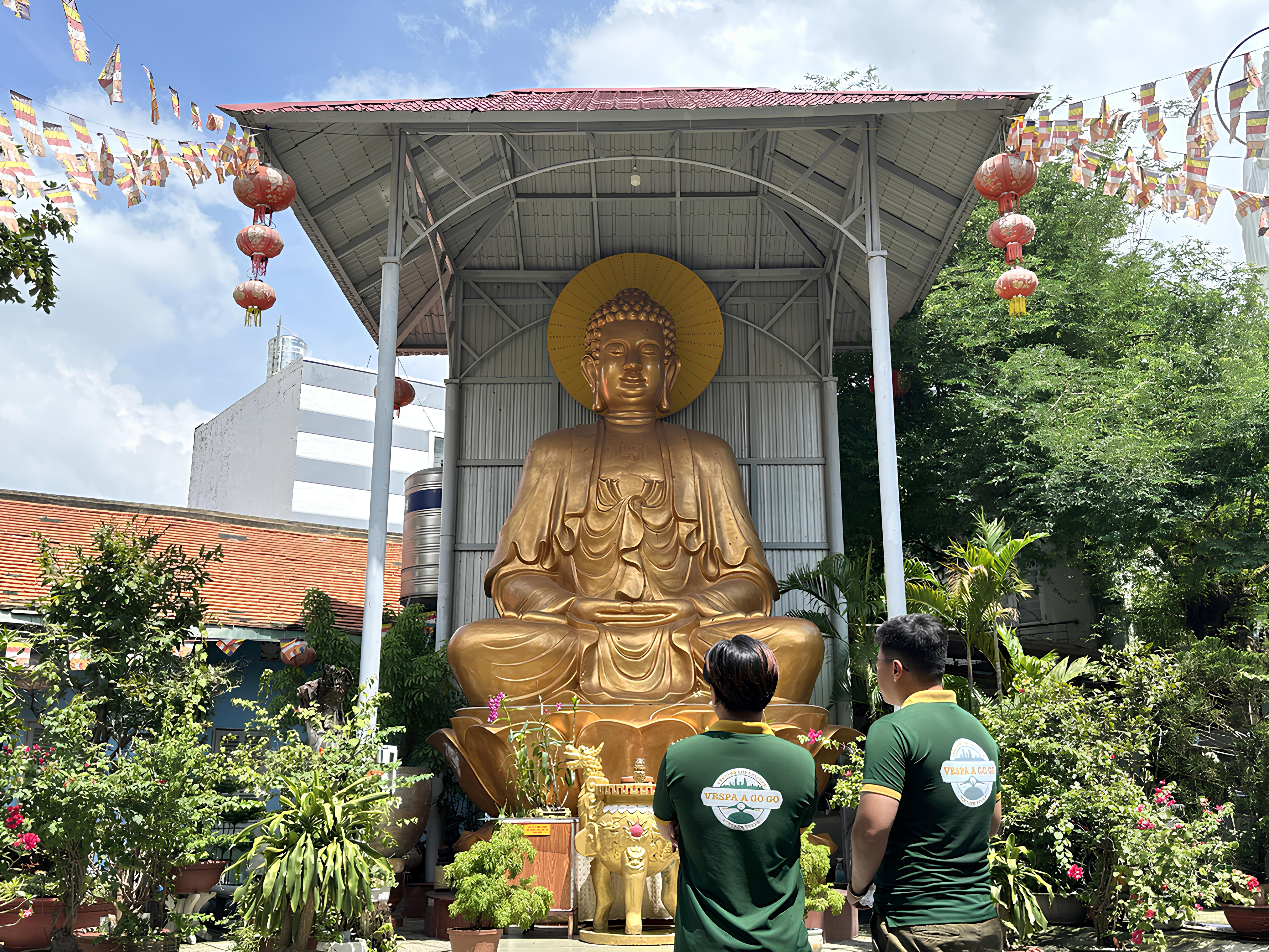 Email: support@vespaagogo.com
Email: support@vespaagogo.comTravel Tips
- Home
- Travel Tips
Most Unique Temples and Pagodas in Saigon: Exploring Ho Chi Minh City's Sacred Spaces
2025-09-01
Spiritual travel is one of the popular options for retreats nowadays
Ho Chi Minh City, also known as Saigon, is the largest city in Vietnam and boasts a blend of modern skyscrapers, historical architecture, bustling street life, and diverse cultural traditions. Among its many attractions, the city is home to numerous temples and pagodas that serve as important spiritual centers for locals and offer insight into the religious diversity of the region. From small neighborhood shrines to grand temples, these places of worship provide visitors with a glimpse into Vietnam’s religious practices, architecture, and culture. Check out our list of some of the most unique temples in Saigon!
Pro-tip! Before visiting any temples in Saigon, check out our guide on cultural tips.
Jade Emperor Temple (Điện Ngọc Hoàng)
Located in the heart of District 1, you will find one of the most famous temples in Saigon, the Jade Emperor Temple. It is a temple built in 1906 by a Cantonese migrant, Liu Daoyuan, who was a follower of Ming Shi Dao (Path of Enlightening Holy Masters) sect, a religion movement in Southern Vietnam during early 20th century. This movement preached syncretism of the three Eastern religions: Buddhism, Taoism and Confucianism. So going here, you can learn about all these three important religions in Vietnam.
The main hall is dedicated to the Jade Emperor, who is believed to be the ruler of heaven in Taoist mythology, the top god in Taoism. There are also numerous Taoist deities who serve under the Jade Emperor in heaven. Another hall is dedicated to the Ten Kings of Hell which show you a fascinating journey in the afterlife according to Taoist and Buddhist belief.
Crawling through the temple, you will notice its intricate carvings, woodwork, and statues, all set within a dense, atmospheric environment filled with incense smoke and the glow of candles.
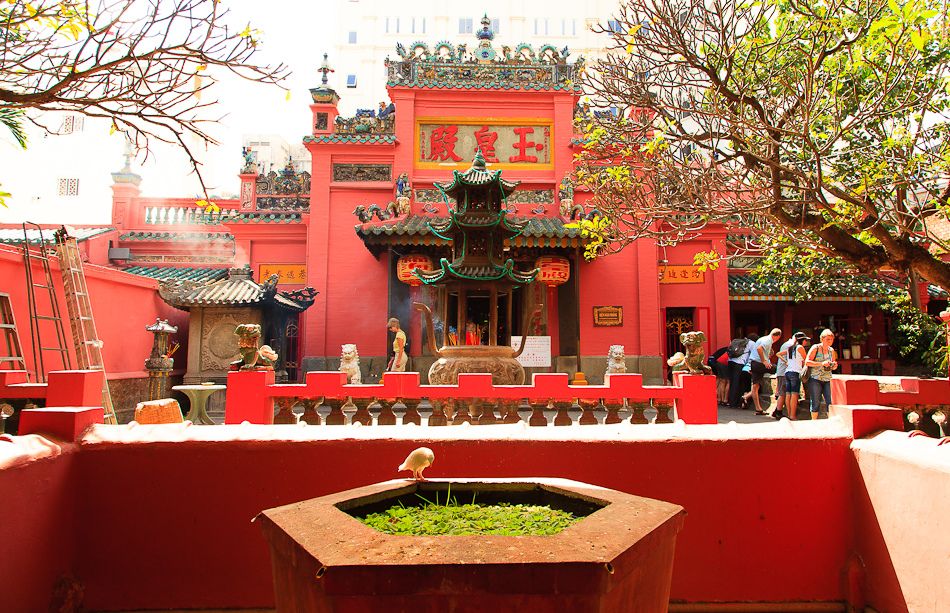 Jade Emperor Temple - the temple in Saigon where people will come to pray for children
Jade Emperor Temple - the temple in Saigon where people will come to pray for children
And the most renowned room in this temple is for the Kim Hoa Thanh Mau (Golden Flower Empress) and Twelve Midwives, deities of fertility who are believed to have the power to bless and make women pregnant.
Fun fact! This temple gained international popularity when it was visited by United States President Barack Obama in 2016.
Thien Hau Temple (Miếu Bà Thiên Hậu)
Dedicated to Thien Hau (Mazu), Chinese Goddess of the Sea, known for protecting fishermen and sailors, Thien Hau Temple is located in Cho Lon, the city’s Chinatown in District 5. It was built by the Cantonese community around 1760 and remains a significant religious site for the Chinese-Vietnamese community. Since the Cantonese is the largest among the five Chinese groups in Cho Lon, this temple is also the largest and the most renowned sacred site in Chinatown.

Thien Hau Temple - a Chinese-style temple in Saigon dedicated to the Goddess of the Sea
The temple’s architecture is typical of traditional Chinese temples, with tiled roofs, and intricate wood carvings. Inside you will find that it is richly decorated with vibrant colors and filled with statues, lanterns, and incense coils that are hanging from the ceiling. Worshippers will come to pray for protection and safe travels, especially those embarking on journeys at sea. Thien Hau Temple is particularly busy during festivals such as the Tet (Lunar New Year), when many people come to offer prayers and celebrate. You can also expect occasional lion and dragon dance performances in front of the temple’s front yard.
Join our Saigon Secrets Tour and visit the most unique temples in Saigon’s Chinatown (Cho Lon)!
Mariamman Hindu temple (Đền Bà Mariamman)
The word ‘Mari’ means ‘rain’ and ‘Amman’ means ‘Mother’, thus, Mariamman is the revered Mother Rain goddess of the Tamil community in Southern India. This Indian region was once also colonized by the French in the 19th century, so many residents in Tamil migrated to Saigon, bringing their belief of Mariamman with them.

Mariamman Hindu temple - a bridge connecting Indian and Vietnamese culture and belief in Ho Chi Minh city
This goddess is also believed to be an avatar of goddess Kali, wife of Lord Shiva, in Hinduism. The Vietnamese also respectfully worship an avatar of Kali, Bà Đen (the Black Lady), in Southern Vietnam, so they also come to this Hindu temple to pray for blessings and protection by facing the stone wall of the main altar.
Besides the main goddess Mariamman, the temple also houses many other beautiful sculptures dedicated to Trimurti, Brahma - Vishnu - Shiva, their consorts and many other Hindu deities.
This sacred Hindu temple is a bridge connecting the two Indian and Vietnamese communities in Saigon, and is also the best place to learn about Hinduism in Ho Chi Minh city.
Saigon Cao Dai temple (Thánh Thất Cao Đài Sài Gòn)
Jesus and Buddha in one temple, what?
Caodaism is a unique religion originating from Vietnam, established by Ngô Văn Chiêu in the city of Tay Ninh in 1926. This religion merges many elements in Vietnamese folk religion with many other foreign religions such as Confucianism, Taoism, Buddhism and Catholicism. So this is unique temple where you can see the Buddha and Jesus worshipped in one place! However, this is actually a monotheistic religion since it worships the Divine Eye of God as the highest entity.

Cao Dai temple - a unique temple that merges Eastern and Western religions
Many visitors traveling to Ho Chi Minh usually pay a visit to the Cao Dai Holy See in Tay Ninh city after seeing the Cu Chi tunnel. But you can easily learn about this fascinating religion right in the heart of Saigon at Saigon Cao Dai temple at 891 Tran Hung Dao street, district 5. This is the largest Cao Dai temple in Ho Chi Minh city and the only three-story Cao Dai temple in Vietnam. It was established by Cao Dai pope Pham Cong Tac in 1949 on the site of an old French villa.
Going inside, you will be surrounded and overwhelmed by a world of religious symbols and icons from East to West, of familiar faces from Sun Yat-sen to Victor Hugo!
Giac Lam Pagoda (Chùa Giác Lâm)
Arguably one of the oldest pagodas in Saigon, Giac Lam Pagoda was constructed in 1744 by a Chinese monk named Lý Thụy Long. It was then entrused to members of the Linji Zen Buddhist sect. Located in the Tan Binh District, this Buddhist pagoda is known for its simple yet eye-catching architecture, perfectly reflecting traditional Vietnamese pagoda design. The pagoda's name translates to "Feel the Woods" which is fitting given its peaceful surroundings and the calm it offers away from the noisy city.
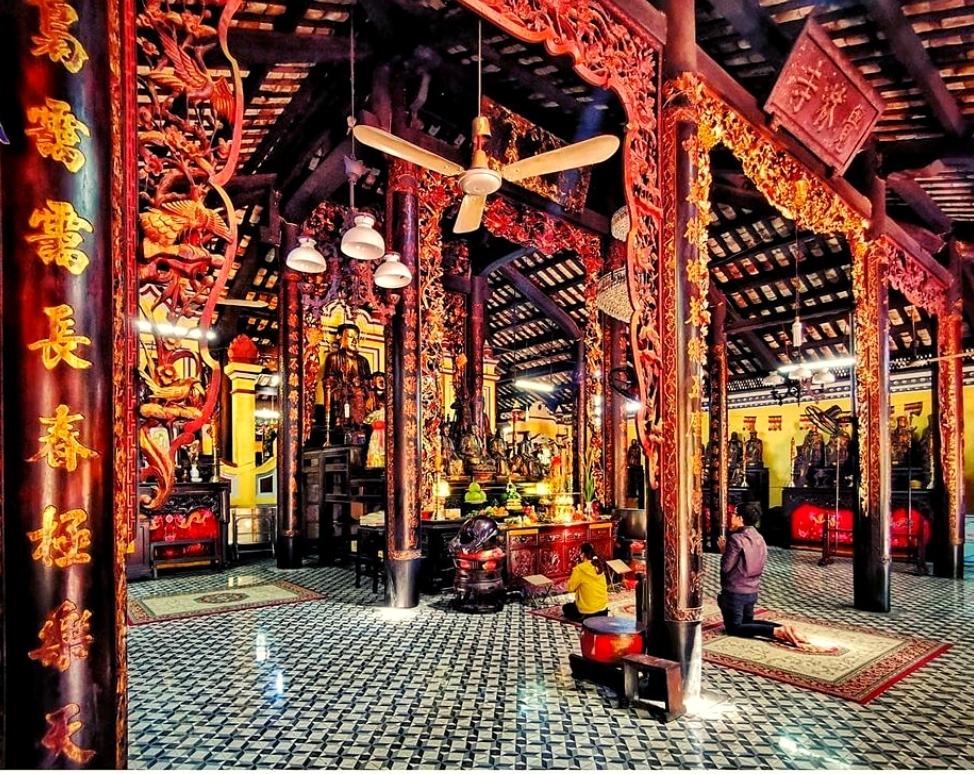 Giac Lam Pagoda - A place with unique Vietnamese traditional architecture
Giac Lam Pagoda - A place with unique Vietnamese traditional architecture
The main hall of the pagoda is dedicated to Phật A Di Đà (the Amitabha Buddha) and various Bodhisattvas, Guardians along with intricate carvings and murals depicting stories from Buddhist scriptures. In total, Giac Lam pagoda houses around 113 unique ancient sculptures made by the finest local craftsmen. Most interestingly, you can also find an altar for president Hồ Chí Minh in the patriarchs’ hall!
One of the main attractions is the seven-story stupa that offers stunning views of the pagoda grounds. If you plan to visit Giac Lam Pagoda you can join ceremonies, offer incense, or simply enjoy the serene atmosphere of the pagoda’s gardens.
Fun fact! Bodhisattvas are beings who haven’t entered paradise so they can help others attain enlightenment.
Xa Loi Pagoda (Chùa Xá Lợi)
The term 'Xa Loi' in Vietnamese ('sarira' in Sanskrit) means 'sacred relic', pearl-like objects reportedly found amongst the cremated remains of Buddhist figures. And this pagoda built in 1956 is dedicated not only to Sakyamuni Buddha's relics but also to a real-life Bodhisattva in Vietnam: Thich Quang Duc.
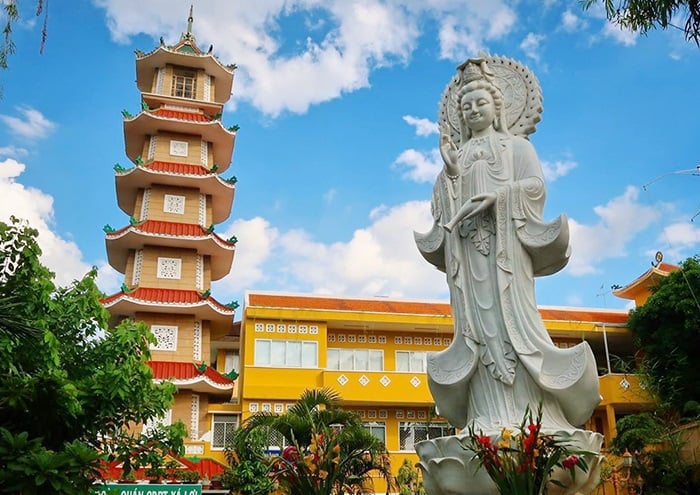
Xa Loi Pagoda - A historical site that has witnessed important events in the Vietnam War in Saigon
Xa Loi Pagoda is well-known not just for its spiritual significance but also for its role in Vietnamese history. In 1963, it became a center of Buddhist opposition to the South Vietnamese government, which led to a government crackdown and the infamous self-immolation of monk Thích Quảng Đức, leading to a major turning point in the Vietnam War (known as the American War in Vietnam).
Fast forward to present day, the pagoda serves as a place of peaceful worship and reflection. Be sure to check out the impressive main hall and the arch above it, which is containing the holy relics of the Buddha.
Vĩnh Nghiêm Pagoda (Chùa Vĩnh Nghiêm)
Located in District 3, Vĩnh Nghiêm Pagoda is one of the largest and most impressive pagodas in Ho Chi Minh City. This famous pagoda was founded in 1964 when two monks from Nam Dinh province named Thich Tam Giac and Thich Thanh Kiem came South to spread the teachings of Truc Lam Zen Buddhism.
The name itself, Vinh Nghiem, was actually the name of an ancient Truc Lam center in Bac Giang province. That is why this pagoda still preserves many elements of traditional Buddhism in Northern Vietnam. The main tower, which stands at 40 meters tall, is a dominant feature of the pagoda and can be seen from various points in the city.
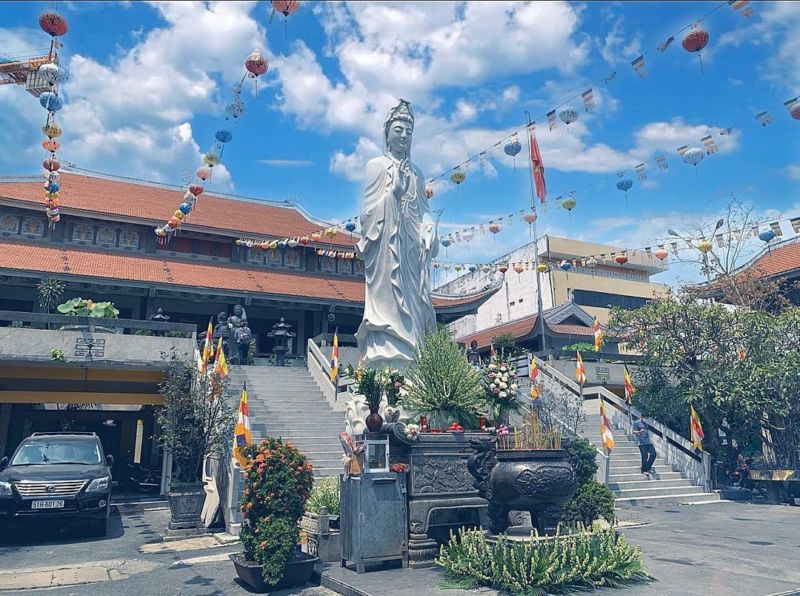
Vinh Nghiem Pagoda - One of the largest pagoda in Saigon where people can come and immerse themselves in the tranquility
The pagoda's plan was endorsed by the new United Vietnam Buddhist Association which was established after the coup of president Ngo Dinh Diem in 1963. This fund was raised by the community of Buddhist monks and nuns from the North living in Saigon at the time.
The pagoda is an important center for Buddhist worship and education, and it features statues of the Buddha, as well as Bodhisattvas like Avalokitesvara. The pagoda grounds include a courtyard where devotees can light incense and pray, as well as a bell tower and a lotus pond. Vĩnh Nghiêm Pagoda is also known for its annual Vu Lan festival, a Buddhist holiday that honors ancestors and parents, drawing large crowds of worshippers.
Ten Thousand Buddha pagoda (Chùa Vạn Phật)
'Van' means 'Ten Thousands' and 'Phat' is 'Buddha', and there are more than 10,000 Buddha statues in this one pagoda, the place with the most Buddhist statues in Vietnam!
This Mahayana Buddhist pagoda was built by two Cantonese monks named Thich Dieu Hoa and Tang Duc Bon in 1959 as a place of study and worship for Buddhist monks in Cho Lon, Chinatown of Saigon. At that time, the neighborhood was already built up, so the only option to design the pagoda was going up, thus, there are 5 stories in this structure.

Van Phat pagoda - the pagoda holding record of the most statues in one place
Amazingly, each story in this pagoda indicates a certain realm in Buddhist doctrines. The ground floor is Hell, dedicated to Ksitigarbha bodhisattva. The first floor is Human’s realm, dedicated to the most famous Buddhist figure, Avalokiteśvara bodhisattva. The second floor is for two major Buddhas, Amitabha and Bhaisajyaguru. The third floor is where the pagoda’s keepers reside. And the fourth floor is where you will meet the founder of Buddhism himself, Gautama Buddha, and four walls filled with mini Buddha’s statues. A secret that most people do not know is under the Buddha, inside the lotus flower’s petals, there are thousands of smaller Buddha’s statues.
The rooftop is designed to become a zen garden, but it is now locked away from outsiders and only accessed by the monks. This is probably the best place to learn about Chinese Mahayana Buddhism, and the best thing is, it is located not far from Saigon's city center.
Buu Long pagoda (Chùa Bửu Long)
This place looks a lot like pagodas in Thailand and Cambodia, so it is usually referred to as ‘Thai pagoda’ by residents in Saigon. Actually, it is 100% a Vietnamese place of worship.

Buu Long pagoda - the sacred site voted as one of the most beautiful pagodas in the world
As an effort to stride away from Chinese influences in Buddhism, layman Vo Ha Thuat built Buu Long pagoda in 1949 and tried to bring Vietnamese Buddhism closer to the original Theravada branch. This location used to be considered quite far away from Ho Chi Minh city’s center, but it is now very easily accessed by the new Metro Line 1!
This is absolutely a unique site in Saigon, as it was once ranked by National Geographic magazine as one of the top 10 pagodas with the most unique architecture in the world. The highlight of the pagoda is the stupa called Gotama Cetiya, the largest stupa in Vietnam. This is a place to worship holy relics of the Buddha and the other monks. Surrounding it are small towers, all made of copper, with a golden color.
Come explore the temples and pagodas of Saigon with Vespa A Go Go
The temples in Saigon offer a unique window into Vietnam’s diverse religious practices and its history. Whether Buddhist, Taoist, or Hindu, these sacred spaces provide visitors with a sense of peace and reflection amidst the energy of the city. Join our Before Saigon and see some temples up close!

